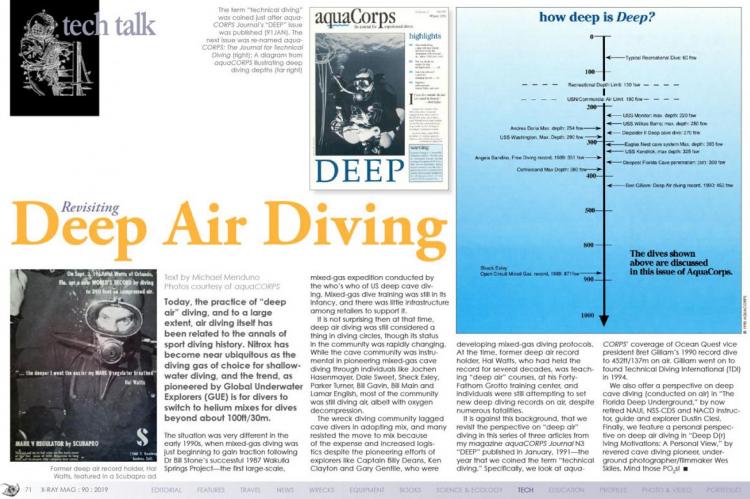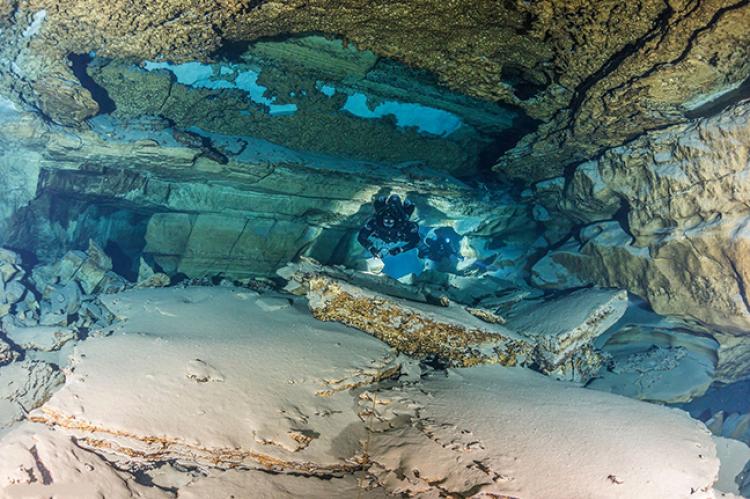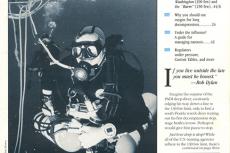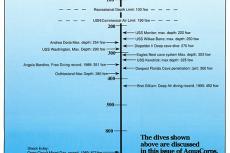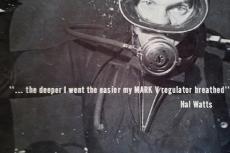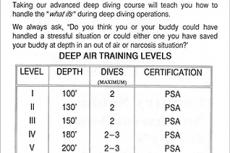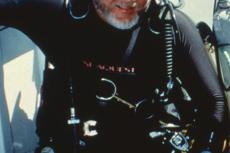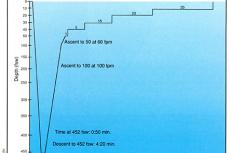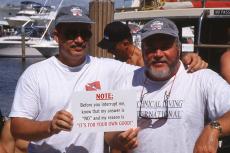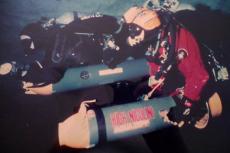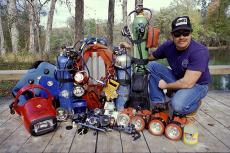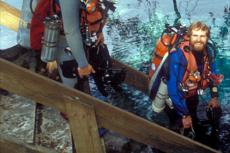Revisiting Deep Air Diving
Today, the practice of “deep air” diving, and to a large extent, air diving itself has been related to the annals of sport diving history. Nitrox has become near ubiquitous as the diving gas of choice for shallow-water diving, and the trend, as pioneered by Global Underwater Explorers (GUE) is for divers to switch to helium mixes for dives beyond about 100ft/30m.
The “Flag Room” (360ft/110m) at Diepolder II (Sand Hill Ranch Scout Reservation, Hernando County, Florida, USA) discovered by Dale Sweet in 1979 on one of the first successful mix dives using trimix. Believing it was the end of the cave, Sweet placed a flag there (not shown), hence the name. Sheck Exley dived to the room on air in 1981 in his famous “Salute The Flag” dive. Dustin Clesi placed that guideline shown nearly three decades ago.
Tags & Taxonomy
The situation was very different in the early 1990s, when mixed-gas diving was just beginning to gain traction following Dr Bill Stone’s successful 1987 Wakulla Springs Project—the first large-scale, mixed-gas expedition conducted by the who’s who of US deep cave diving. Mixed-gas dive training was still in its infancy, and there was little infrastructure among retailers to support it.
It is not surprising then at that time, deep air diving was still considered a thing in diving circles, though its status in the community was rapidly changing. While the cave community was instrumental in pioneering mixed-gas cave diving through individuals like JJochen Hasenmayer, Dale Sweet, Sheck Exley, Parker Turner, Bill Gavin, Bill Main and Lamar English, most of the community was still diving air, albeit with oxygen decompression.
The wreck diving community lagged cave divers in adopting mix, and many resisted the move to mix because of the expense and increased logistics despite the pioneering efforts of explorers like Captain Billy Deans, Ken Clayton and Gary Gentile, who were developing mixed-gas diving protocols. At the time, former deep air record holder, Hal Watts, who had held the record for several decades, was teaching “deep air” courses, at his Forty-Fathom Grotto training center, and individuals were still attempting to set new deep diving records on air, despite numerous fatalities.
It is against this background, that we revisit the perspective on “deep air” diving in this series of three articles from my magazine aquaCORPS Journal N3 “DEEP” published in January, 1991—the year that we coined the term “technical diving.” Specifically, we look at aquaCORPS’ coverage of Ocean Quest vice president Bret Gilliam’s 1990 record dive to 452ft/137m on air. Gilliam went on to found Technical Diving International (TDI) in 1994.
We also offer a perspective on deep cave diving (conducted on air) in “The Florida Deep Underground,” by now retired NAUI, NSS-CDS and NACD instructor, guide and explorer Dustin Clesi. Finally, we feature a personal perspective on deep air diving in “Deep D(r)iving Motivations: A Personal View,” by revered cave diving pioneer, underground photographer/filmmaker Wes Skiles. Mind those PO2s! ■
For the Record: 452 FSW on Air
aquaCORPS N3, “DEEP,” January 1991
Text by Michael Menduno
Last February 1990, Bret Gilliam, former Vice President of Diving Operations at Ocean Quest International, set a world record of 452fsw/137msw for deep air dives, surpassing Neal Watson’s 1968 record by 15ft/5m. Using a stripped-down set with a single 95, one regulator and three pressure-rated gauges, Gilliam’s calculated five-minute drop, followed by 76 minutes of air decompression, was one of a series of dives, aimed at reaching 500fsw/153msw.
Regarded as stunt diving by many, Gilliam’s dive highlighted the small secretive community of deep bounce divers—deep freaks—people like Hal Watts, Dick Oberlies and Tom Mount, many of whom have been making air dives in excess of 300 ft/91m for more than 20 years. For some, deep air diving was a carry-over from their early military experiences—in Gilliam’s case, deep water submarine reconnaissance, before the general availability of mixed gas. For others, perhaps it’s a habituation with hyperbaric nitrogen, or the thrill of doing something that “can’t be done.” Says who?
The diving community’s reaction to Gilliam’s project was mixed. While the dive drew fascination from the recreational community—a consequence perhaps of limited diving depths—the repercussions of Gilliam’s 130ft/40m plus dive echoed through the trade. At least two individuals who volunteered to participate in the project as advisors withdrew, fearing the negative publicity would jeopardize their standing. Others, convinced of Gilliam’s sanity and his inalienable right to dive, remained in awe.
The “high-tech” bloc was more skeptical. Though no one was phased by the depth—numerous groups are building to 300-500ft/91-153m working depths—many questioned his method and motivation. One veteran cave diver, whose circle is regularly making mix dives in the 300ft range, with 45 to 60-minute bottom times, compared Gilliam’s dive to setting the Bonneville Salt Flats land speed record while drunk. What’s the point?
Diving has always been an interplay of personal moxie and technology. In many respects, the deep (air) crowd has forsaken the latter; choosing instead to explore the limits of human physiology.
At 400ft/123m, most individuals are reduced to vegetables, unable to perform the simplest tasks such as clearing a mask or operating a BC. The previous record holder, Neal Watson, trained for the dive, for more than a year. His challenge? Remembering to clip the depth marker to the line. When I asked him what it was like at 437ft/134m on air, Watson replied, “I don’t remember.” Since that time, eight people have died trying to duplicate the experience.
If nothing else, Gilliam’s dive demonstrates that individual physiology plays a quantifiable role in diving, and though limits exist, their boundaries remain fuzzy. Gilliam, who prepared for the dive for more than a year, says he was able to perform higher math at depth, avoiding a CNS toxicity hit through training, limited exposure, deep breathing and perhaps just luck, is an extreme on the curve.
Interestingly enough, by comparison, Sheck Exley’s mixed-gas dive to 870ft/266m two years earlier—a 20-minute plunge in a Mexican cenote, requiring 13.5 hours of decompression and 34 stage bottles carried in fives evoked near reverence in the community.
From one perspective, their motivations appear similar. For the record: Both pushed limits that others had died exceeding. Is the difference just a penchant for technology? Or is it, in Exley’s case, the promise that others will be able to follow, at least part way? ■
The Florida “Deep” Underground
Text by Dustin M. Clesi
Stargate, Lost Forty, Twin D’s, Eagle’s Nest, Double Keyhole, Numero Uno, Jonah’s Gate, Nexus, Vaughn’s Hope ... these are names that command the immediate attention of the knowledgeable Florida cave diver—proper nouns that dominate private conversations, with information usually conveyed in quiet tones. This is the Land of the Cobalt, the Realm of the Few.
Many of these dive sites share common traits: fresh water with 300ft/91m plus visibility, trunk passages large enough to accommodate tandem Mack trucks, breakdown as large as a house, “Grossehalle” rooms wider than most stadiums, and most common of all, depth.
That is to say, real depth, not just your garden-variety 120ft/37m deep spring. With ceilings at 270ft/82m and major restrictions at 310ft/94m, these caves represent some of the deeper systems known in the Western Hemisphere. Deep cave diving—the specialists’ specialty.
Although professional cave diving is finally coming out into the open, deep cave diving still remains in the closet.
Unlike various other cave diving specialties (e.g., staging, advanced decompression, side mount, use of diver propulsion vehicles, cave surveying), deep cave diving below 200ft/61m utilizing compressed air continues to exist in a category of its own for which no generally-accepted procedures of formal instructions exist—a category that incorporates one or many of the above specialties, and yet will always present a special host of hazards unique unto itself.
In recognition of these hazards, the two national cave diver organizations, the National Speleological Society-Cave Diving Division (NSS-CDS) and the National Association of Cave Diving (NACD), have stressed the avoidance of diving beyond 130ft/40m in caves since 1976. This recommendation stems from concerns over the use of compressed air below the 130ft/40m mark and complies with the standards of advanced diving within the open-water diving community. Unfortunately, the advanced diver is left to his or her own devices because neither organization has yet to address what procedures are acceptable to use beyond those depths.
Meanwhile, the few continue their adventures. It is estimated that five to seven percent of all active cave divers routinely participate in extreme-exposure caving. Of course, this number does not include the many occasional deep divers, the “tour cavers,” who “just want to see one time.” If these divers were included, the count of deep cavers would run much higher.
Two decades of trial and error
Recorded experiences of trained cave divers penetrating the deep ones go back to 1969. Beyond that, information becomes very sparse. Maps and diagrams of major explorations by divers attempting the more notorious systems began surfacing in 1971 and remain in circulation among the interested members of the cave diving community even today.
In the early 1970s, the new single-hose regulators, double 72s (overfilled to 3300 psi), and fast swimming were the standard bill of fare for diving in deep caves. Those divers with the highest resistance to the effects of extreme nitrogen saturation and who more aggressively managed their air supplies were the divers who laid the most line.
It was during these early deep cave explorations that the organized cave diving community suffers its first accidents. Regrettably, of the 18 certified cave divers lost since 1968, 12 drowned due to incidents occurring at depth (most beyond 200ft/61m). Four of these accidents occurred within the same cave system (Eagle’s Nest). Cavers knew then, and know today, of the unique hazards present in deep caves. Nevertheless, divers continue to go beyond the recommended 130ft/40m depth limit for air dives.
New tools for the cave diver began surfacing in the mid-1970s. Extremely powerful cave-diving lights used to penetrate large, sunken chambers started emerging from sophisticated backyard workshops. With the premier of the French Mk IV diver propulsion vehicle (DPV), deep cavers were granted a workhorse with which to extend their penetrations even further. This vehicle, rated to 300ft, could carry a light load and would offer a respite to the rider from extreme nitrogen narcosis by limiting exertion at depth. Unfortunately, the reliability of this DPV could not be taken for granted and mechanical failures were not uncommon.
The deepest penetration of a Florida cave on air was conducted by Sheck Exley to 360ft/110m in 1981. Known as the “Salute the Flag Dive,” this penetration remains impressive to this day, considering the negotiation of a major restriction at 310ft/94m that was accomplished in the process.
During the early 1980s, unwritten rules gleaned from a hard decade of trial and error began emerging among the deep cavers. To name a few:
• Be fully trained and develop experience in shallower system first;
• Dive consistently with the same buddy or small group of buddies to become intimately familiar with their equipment and cave diving practices;
• Always swim slowly and with purpose;
• Use double buoyancy compensators;
• Pad schedules with oxygen [for decompression].
It was also at this time that trimix was first known to have been used in a Florida cave.
To relieve the boredom of horrendous decompression schedules, liquid snacks, magnetic chessboards, interesting reading, and catheters usually entered the sink basin with the diver, along with extra gas cylinders. Skin bends were common and chamber treatments were occasionally the “price paid” for more serious bends hits.
Since the mid-1980s, new, more serious tools for deep cave diving have come into play. Mixed gases, decompression habitats, German DPVs, and more complex decompression schedules, in addition to the normal heavy cave diving gear, are now being routinely used in Florida. Experimental, computerized rebreathers currently being tested in caves [Bill’s Stone’s Cis-Lunar Development Laboratories units] may eventually offer the subterranean ultimate and the cave diver’s dream: an unlimited air supply.
Why air?
Why do experienced deep cave divers continue to use compressed air below 130ft/40m when alternatives are now available? I recently asked five of the most well-known deep cave divers just this question. Responses varied: “I like it”; “Air is more than adequate to XXX level”; “Air doesn’t make me cold”; “Air requires a shorter hang time.” [Ed. note: Other reasons sometimes given are “Mix is too expensive,” and “Mix requires too much time and support; we can do without it.”]
All of those interviewed agreed that compressed air was “standard” among this select group at 200ft/61m and further indicated a “comfort zone” (of mental and motor function) at 250ft/76m.
As for the limits of air, all expressed the belief that the use of compressed air at 300ft/91m and below was excessive and unnecessary, and would likely jeopardize the success of the planned exploration.
When considering their views, bear in mind that these individuals have developed high tolerances to nitrogen saturation over the years of experience in caves. While they do not view themselves as transgressing the laws of physiology, their experiences are not necessarily transferable to other less-seasoned divers. In fact, when the time comes to gear up, these old hands often shun the newer cave divers, or “young guns,” in preference to their regular diving partners with whom they have a long history of shared experiences and trust.
Obviously, what became a very personal type of cave diving almost two decades ago still remains that way to this day... out on the edge. ■
Deep D(r)iving Motivations: A Personal View
Text by Wes Skiles
Every time I think of deep diving, both good and bad memories surface together in my mind. I can recall those exciting evenings over 15 years ago when friends and I would drive from Jacksonville to Eagle’s Nest just for an evening dive. We were full of anticipation back then for the promise each dive held. Among other things, these dives offered the challenge of testing ourselves against narcosis, which we viewed as an obstacle to be overcome so that we could be “good deep divers.” Mastering the depths was extremely satisfying to my ego.
I must admit that I enjoyed the sensation of narcosis, but the real reason I was there was to develop my skill as a deep diver. For some unknown reason, I just had to be able to say that I had been deep on air. I only wish that I could have known back then the scenarios that were rushing full speed towards me and the consequences of my misdirected actions.
One of the most common reasons people experiment with deep diving is to see how they handle narcosis. Invariably, they share these experiences with their diving peers, but more often than not, they hold some of the truth back about how they reacted to the depth; either they do not want to admit that they experienced any level of narcosis, or they want to give the impression that they “overcame it” and “kept it under control.”
I am sure that there are a few divers that can be completely honest and objective about their experiences. But most of us would have to admit that we have been a little more narked than we were willing to let on to our companions at the time. This situation is not helped any by the existence of those anomalous divers who seem to have total immunity to the effects of narcosis. Unfortunately, these unusual individuals—along with others who simply deny feeling any effects—set the standard for the mass of divers interested in quantifying their capacity to dive deep.
It was hard to admit at the time, but my first face-slamming experience with narcosis occurred at just 160ft/49m. I was crushed; demoralized. I knew that experience and repetition would help get me deeper, but how was I to get that experience if I admitted to anyone that I got narked at 160ft? Eventually, after about 20 dives, I had worked my way well past 200ft/61m. I was finally the victor; I had beaten narcosis, or so I thought.
At this point, let me pose the same questions I ultimately had to ask myself: What is the point? Why would you want to go that deep on air? What purpose is served beyond the excitement of the moment? To my mind, if you do not have a really solid justification and you are doing it for the challenge alone, then it becomes just another cheap thrill. Only not so cheap.
Deep diving on air must be approached with a strong sense of the possibilities of uncontrollable circumstances and negative outcomes.
Our dive plan that day was to descend to a depth of 165ft/50m and then to explore a virgin cave passage downstream. The depth and distance we would both be traveling downstream with the current before turning the dive and exiting against the current were accounted for by our use of a conservative 1/5-air rule, that is, we would begin our return when we had used 1/5 of our air supply. This dive would require an additional stage bottle, as well as oxygen for decompression. Certified cave divers, we descended on our adventure.
The dive proceeded as planned, with the new passage being explored and survey data collected. When the allotted air was consumed, we began our return trip, having spent considerable time already at the 170ft/52m level. We gave each other the double-time signal, which meant we would pick up the pace during our exit. Retrieving stage bottles on the way, we prepared for our final exit from the cave.
Seconds later my partner signaled me, indicating that he felt so-so. Although I did not comprehend the scope of his problem, I realized that we had better slow down. Then, swimming only a few feet farther, I turned to see my friend losing consciousness. My mind raced, with heartbeat and breathing following, as the full impact of the situation hit me. Fortunately, he was still breathing and not yet fully blacked out, but there was no way he was going to be able to get out on his own.
Grabbing him by the arm and pulling him over my shoulder like a sack of potatoes, I began a desperate swim for the exit. Less than a hundred feet later, my body began to succumb to the stress, my brain pounding like tribal death drums. I clearly remember a flash of regrets—not the kind people supposedly have before they die, but much more pragmatic thoughts. Why didn’t I realize that this could happen? Why was doing this dive so important?
By the time I got to deals and promises with God (I will never do this again, really...), I regained control of my runaway breathing. Reorganizing my thoughts, I got underway at a pace I hoped would keep us both alive. It was still a touch-and-go exit, but both of us survived.
An analysis of our situation pointed to a combination of CO2 buildup and narcosis—a very real problem that is often ignored by air-breathing deep divers. Our own level of difficulty with this problem could only have been amplified at a greater depth. I ask the air-breathing, deep-diving readers if they are confident of their own abilities to handle a sudden injection of mental and physical stress at depth. If the answer is a smug “yes,” how do you know that?
Instead of modifying my dive habits after this incident, I continued to deep dive. Having been the “victor” of that round—at least in my mind—my response was to change buddies and stick with the “challenge” of deep diving. I was in control. An upcoming scenario featuring me as the victim was unthinkable.
These experiences played out in the late ‘70s, when many large, deep cave systems still remained virtually unexplored. I believe my personal motivation at the time was simply to explore deep caves. In retrospect, exploration imperatives were probably only 20 percent of that motivation; I will now admit that the other 80 percent was what I call “deep diving ego syndrome.”
It was on one of my deepest dives, as part of a three-person team exploring a deep tunnel, that things caught up with me. On two previous dives here, I had led the team, so on this third dive, I was to be along “for the ride.” Relaxed, confident and without the responsibilities of leading, I was unconsciously lowering my guard.
The descent and dive went smoothly, with the exception of a couple of minor communication glitches. I was surprised at how far we were getting, and that my buddies had not yet hit their air turn-around point. I called the dive on air and gave the thumbs-up, confident that the others would be ready to turn also. That is when the horror of a narcosis-clogged mind challenged whatever senses I had left.
As I turned to begin our exit out, the others flashed me with their lights, the beam sweeps an imparting sense of urgency. Spinning about in response to a possible emergency, I now faced my buddies who were signaling emphatically that the surface was in the direction we had been swimming. This meant that either I had gotten confused or the both of them had.
Had we turned the dive and begun the exit without my noticing it? Or were my trusted buddies mentally blind with narcosis? This 50/50, coin-toss moment of decision nearly caused me to pass out from the rapid dump of adrenaline entering my system. But it was two against one. Being not sure but shaken, I decided to give in. Either they would lead us to our doom or to dinner. I simply followed them, not at all sure of who knew what.
The gravity of that error ended my misdirected, ego-driven deep dives on compressed air, which, up until that time, had seemed so very important. From that experience, along with a few other not-quite-so-close calls, I began to reassess the reasons that others and I had used to justify a deep dive on air.
Many years have passed since my “air-powered” deep-diving days. Now my friends will tell you that I am reluctant to dive below 130ft/40m without the benefit of a gas mix.
I have come to feel that there is nothing down deep worth visiting while on air. It is just not worth the risk, especially with the advent of mixed-gas sport diving techniques, equipment and table, and with one-atmosphere suits on the horizon.
A wise old diver once told me, “If you stick around long enough, you will see the whole show repeat itself time and time again.” I have been around long enough now to agree with him, having seen the loss of a few divers—some really good ones among them—as the show gets replayed.
Deep diving on air never offers a guaranteed safe return, no matter what your reason and confidence tell you. I constantly hear people say, “Boy, that person is a real good deep diver.”
I now know there is no such thing as getting “good” at deep diving on air. While a person may be truly competent, trusted and liked, their competency will only allow them to be lucky when diving deep.
I now know there is no such thing as getting “good” at deep diving on air. While a person may be truly competent, trusted and liked, their competency will only allow them to be lucky when diving deep.■
Download the full article ⬇︎
